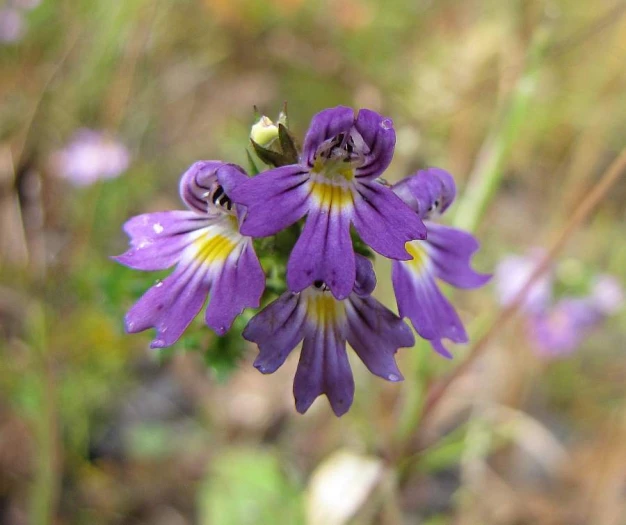Drug Eyebright
(Euphrasia stricta)
Drug Eyebright (Euphrasia stricta)
/
/

christine123
CC BY 4.0
Image By:
christine123
Recorded By:
Copyright:
CC BY 4.0
Copyright Notice:
Photo by: christine123 | License Type: CC BY 4.0 | License URL: http://creativecommons.org/licenses/by/4.0/ | Rights Holder: christine123 | Publisher: iNaturalist | Date Created: 2009-10-05T12:32:40-07:00 |
























Estimated Native Range
Climate Requirements for Harlingen, Texas
| This Plant | Your Site | Plant Suitability for Your Location | ||
|---|---|---|---|---|
| • Precipitation | 26" - 47" | 28" | You should be able to grow this plant with no additional irrigation. | Excellent |
| • High Temp. | 64°F - 75°F | 94°F | Your summers may be too hot for this plant. | Too hot |
| • Low Temp. | 10°F - 33°F | 49°F | OK, but your winter temperatures are warmer than normal for this plant | OK |
This plant may not grow well at your location - your summers are too hot.
Summary
Euphrasia stricta, commonly known as drug eyebright, is an annual herbaceous plant native to a variety of habitats including grasslands, heathlands, and open woodlands across Europe and Asia. It has also been introduced to northeastern North America. Typically, it thrives in well-drained, calcareous soils and is often found in areas with a moist microclimate, such as moorlands and dune slacks. Drug eyebright is a hemiparasite, meaning it obtains some of its nutrients by attaching to the roots of other plants, particularly grasses, without killing them.
This plant is characterized by its small stature, usually not exceeding a few inches in height, and bears tiny, white or purple-tinted flowers with a yellow spot on the lower lip, which bloom in late spring to early summer. The flowers are modest in size but can be quite showy when in dense populations. Drug eyebright is valued in herbal medicine for its purported anti-inflammatory properties, particularly in treating eye conditions, although scientific support for these uses is not robust. In cultivation, it is not commonly found in gardens due to its parasitic nature and specific growing requirements, but it can be of interest to those creating wildlife-friendly or medicinal gardens. It prefers partial shade to full sun and requires a host plant for optimal growth. While not typically associated with significant problems, its parasitic lifestyle should be considered when introducing it to a garden setting.CC BY-SA 4.0
This plant is characterized by its small stature, usually not exceeding a few inches in height, and bears tiny, white or purple-tinted flowers with a yellow spot on the lower lip, which bloom in late spring to early summer. The flowers are modest in size but can be quite showy when in dense populations. Drug eyebright is valued in herbal medicine for its purported anti-inflammatory properties, particularly in treating eye conditions, although scientific support for these uses is not robust. In cultivation, it is not commonly found in gardens due to its parasitic nature and specific growing requirements, but it can be of interest to those creating wildlife-friendly or medicinal gardens. It prefers partial shade to full sun and requires a host plant for optimal growth. While not typically associated with significant problems, its parasitic lifestyle should be considered when introducing it to a garden setting.CC BY-SA 4.0
Plant Description
- Plant Type:
- Height: 0.2-0.5 feet
- Width: 0.1-0.5 feet
- Growth Rate: Moderate
- Flower Color: Purple, White, Yellow
- Flowering Season: Summer
- Leaf Retention:
Growth Requirements
- Sun: Full Sun, Part Shade
- Water: Medium
- Drainage: Medium
Common Uses
Low Maintenance
Natural Habitat
Native to grasslands, heathlands, and open woodlands across Europe and Asia
Other Names
Common Names: Downy Eyebright , Upright Eyebright , Euphraise Dressée , Rigid Eyebright , Arctic Eyebright
Scientific Names: Euphrasia stricta , ? bicknellii , Euphrasia alpina subsp. asturica , Euphrasia asturica , Euphrasia brevipila subsp. reayensis , Euphrasia cebennensis var. edouardii , Euphrasia cebennensis var. edouardii , Euphrasia coerulea , Euphrasia diekjobstii , Euphrasia edouardii
GBIF Accepted Name: Euphrasia stricta